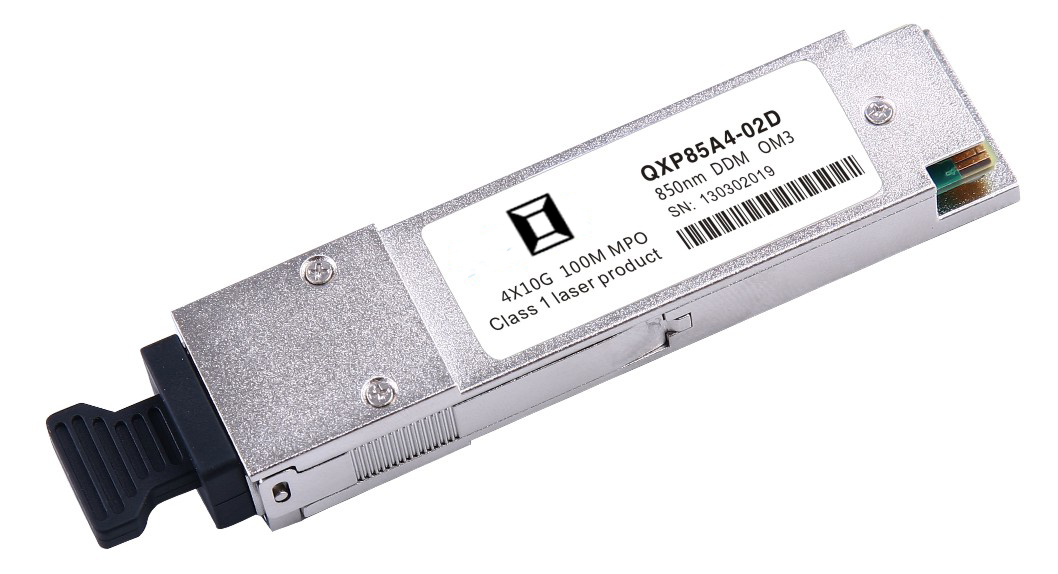
KEY Features
High Channel Capacity: 40 Gbps per module
Up to 11.1Gbps Data rate per channel
Maximum link length of 100m links on OM3 multimode fiber
Or 150m links on OM4 multimode fiber
High Reliability 850nm VCSEL technology
Electrically hot-pluggable
Digital diagnostic SFF-8436 compliant
Case operating temperature range:0°C to 70°C
Power dissipation < 1.5 W
Application
40G Ethernet
Infiniband QDR
Fiber channel
STANDARD
Compliant to IEEE 802.3ba
Compliant to SFF-8436
RoHS Compliant.
HC’s QXP85A4-02D are designed for use in 40 Gigabit per second links over multimode fiber. They are compliant with the QSFP+ MSA and IEEE 802.3ba 40GBASE-SR4.
The optical transmitter portion of the transceiver incorporates a 4-channel VCSEL (Vertical Cavity Surface Emitting Laser) array, a 4-channel input buffer and laser driver, diagnostic monitors, control and bias blocks. For module control, the control interface incorporates a Two Wire Serial interface of clock and data signals. Diagnostic monitors for VCSEL bias, module temperature, transmitted optical power,received optical power and supply voltage are implemented and results are available through the TWS interface. Alarm and warning thresholds are established for the monitored attributes. Flags are set and interrupts generated when the attributes are outside the thresholds. Flags are also set and interrupts generated for loss of input signal (LOS) and transmitter fault conditions. All flags are latched and will remain set even if the condition initiating the latch clears and operation resumes. All interrupts can be masked and flags are reset by reading the appropriate flag register. The optical output will squelch for loss of input signal unless squelch is disabled. Fault detection or channel deactivation through the TWS interface will disable the channel. Status, alarm/warning and fault information are available via the TWS interface.
The optical receiver portion of the transceiver incorporates a 4-channel PIN photodiode array, a 4-channel TIA array, a 4 channel output buffer, diagnostic monitors, and control and bias blocks. Diagnostic monitors for optical input power are implemented and results are available through the TWS interface. Alarm and warning thresholds are established for the monitored attributes. Flags are set and interrupts generated when the attributes are outside the thresholds. Flags are also set and interrupts generated for loss of optical input signal (LOS). All flags are latched and will remain set even if the condition initiating the flag clears and operation resumes. All interrupts can be masked and flags are reset upon reading the appropriate flag register.
Absolute Maximum Ratings
Parameter | Symbol | Min. | Typ. | Max. | Unit | Note |
Storage Temperature | Ts | -40 | - | 85 | ºC | |
Relative Humidity | RH | 5 | - | 95 | % | |
Power Supply Voltage | VCC | -0.3 | - | 4 | V | |
Signal Input Voltage | Vcc-0.3 | - | Vcc+0.3 | V | ||
Damage threshold | 3.4 | dBm |
Recommended Operating Conditions
Parameter | Symbol | Min. | Typ. | Max. | Unit | Note |
Case Operating Temperature | Tcase | 0 | - | 70 | ºC | Without air flow |
Power Supply Voltage | VCC | 3.14 | 3.3 | 3.46 | V | |
Power Supply Current | ICC | - | 350 | mA | ||
Data Rate | BR | 10.3125 | Gbps | Each channel | ||
Transmission Distance | TD | - | 100 | m | OM3 MMF | |
150 | m | OM4 MMF |
Optical Characteristics
Parameter | Symbol | Min | Typ | Max | Unit | NOTE |
Transmitter | ||||||
Center Wavelength | λ0 | 840 | 860 | nm | ||
Average Launch Power each lane | -7.6 | 0.5 | dBm | |||
Spectral Width (RMS) | σ | 0.65 | nm | |||
Optical Extinction Ratio | ER | 3 | dB | |||
Average launch Power off each lane | Poff | -30 | dBm | |||
Transmitter and Dispersion Penalty each lane | TDP | 3.5 | dB | |||
Optical Return Loss Tolerance | ORL | 12 | dB | |||
Output Eye Mask | Compliant with IEEE 802.3ba | |||||
Receiver | ||||||
Receiver Wavelength | λin | 840 | 860 | nm | ||
Rx Sensitivity per lane | Rsens | -9.5 | dBm | 1 | ||
Input Saturation Power (Overload) | Psat | 2.4 | dBm | |||
Receiver Reflectance | Rr | -12 | dB | |||
LOS De-Assert | LOSD | -12 | dBm | |||
LOS Assert | LOSA | -30 | dBm | |||
LOS Hysteresis | 0.5 | dBm | ||||
Notes:
1. Measured with a PRBS 231-1 test pattern, @10.325Gb/s, BER<10-12 .
Electrical Characteristics
Parameter | Symbol | Min | Typ | Max | Unit | NOTE |
Supply Voltage | Vcc | 3.14 | 3.3 | 3.46 | V | |
Supply Current | Icc | 350 | mA | |||
Transmitter | ||||||
Input differential impedance | Rin | 100 | Ω | 1 | ||
Differential data input swing | Vin,pp | 180 | 1000 | mV | ||
Single ended input voltage | VinT | -0.3 | 4.0 | V | ||
Receiver | ||||||
Differential data output swing | Vout,pp | 300 | 850 | mV | 2 | |
Single-ended output voltage | -0.3 | 4.0 | V |
Notes:
1. Connected directly to TX data input pins. AC coupled thereafter.
2. Into 100 ohms differential termination.
Outline Dimensions:mm
![06G266{1T)AR8OCW]E)1)SA.png 06G266{1T)AR8OCW]E)1)SA.png](https://www.glhclink.com/uploads/20230328/202303281537214550.png)
If you need more information , Please contact us .